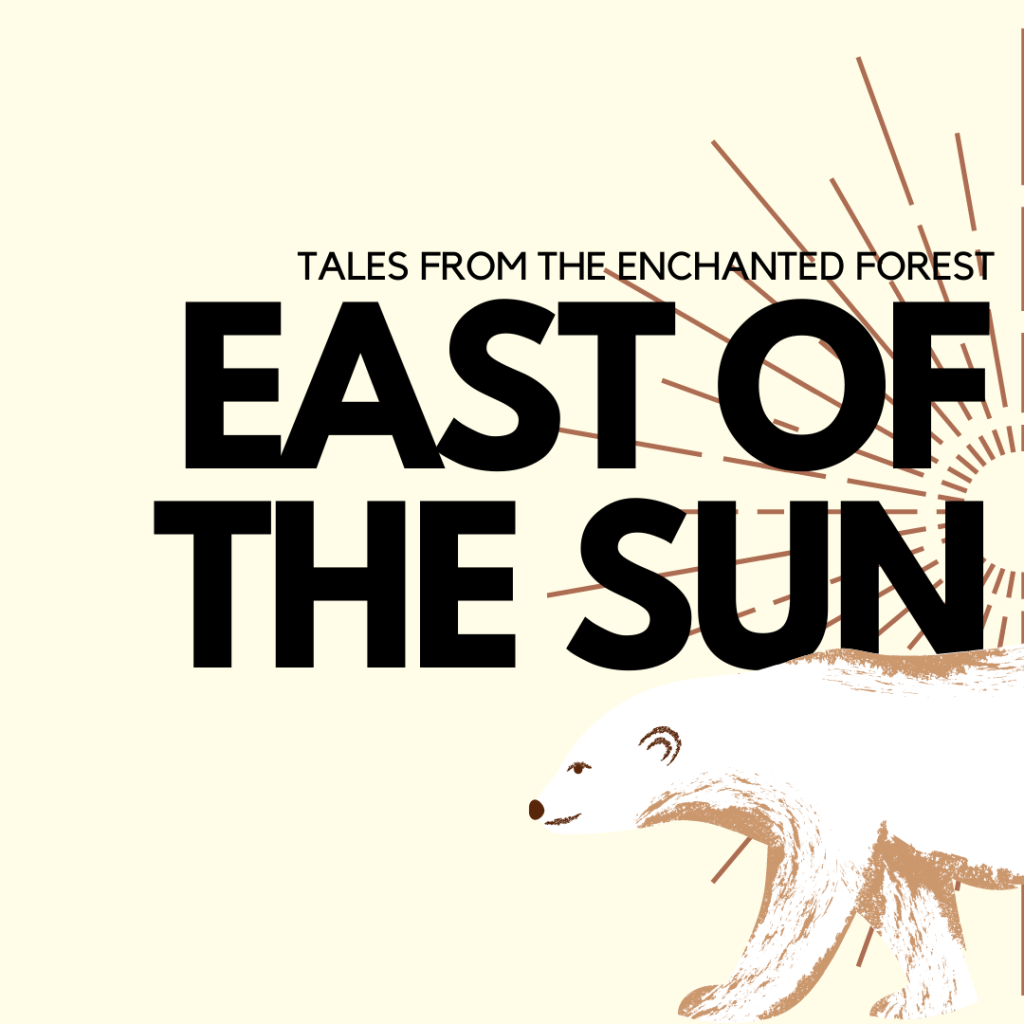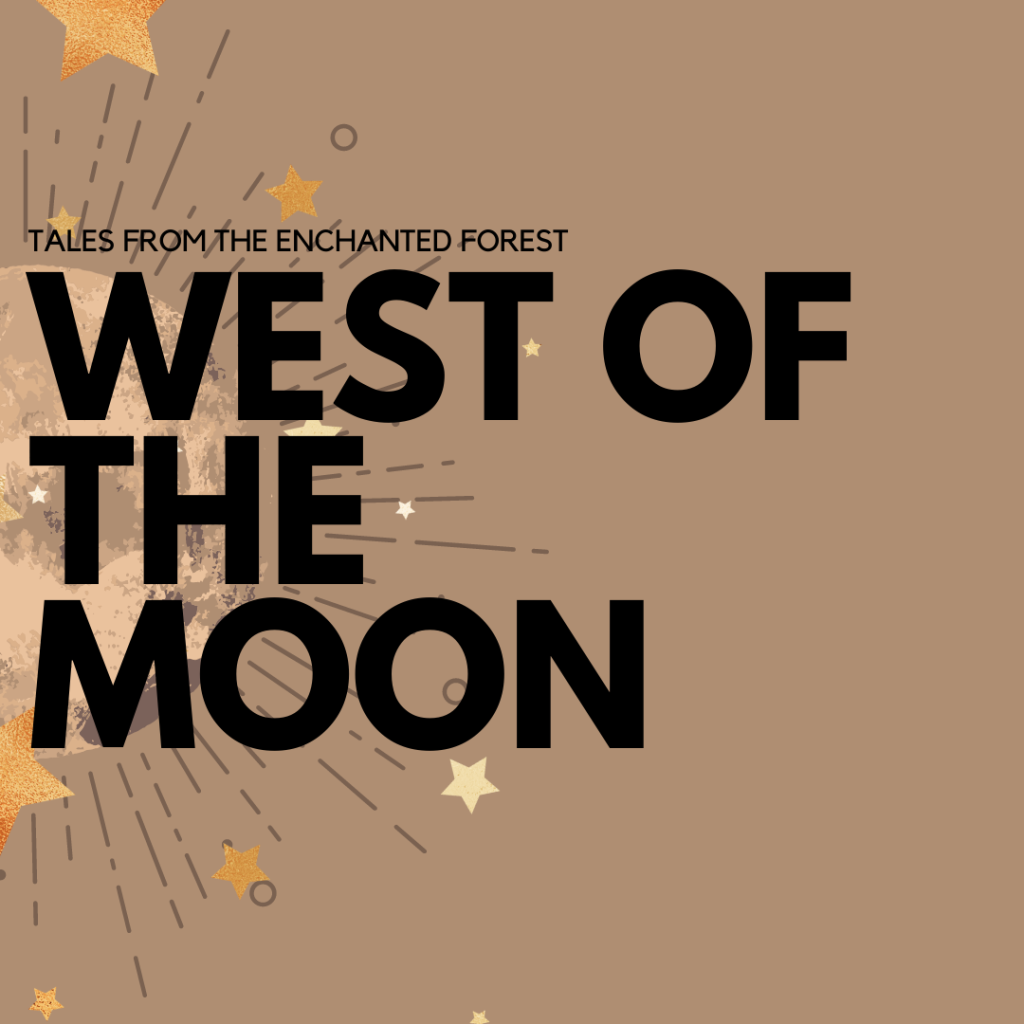



East of the Sun and West of the Moon, also known as Østenfor sol og vestenfor måne, was a story collected by Peter Christen Asbjørnsen and Jørgen Moe for their book, Norske Folkeeventyr, on Norse Fairy Tales. Our version was translated from the original Norwegian into English by George Webbe Dasent.
East of the Sun and West of the Moon follows the Aarne-Thompson-Uther tale type 425, “The Search for the Lost Husband,” with the subcategory 425A: The Animal Bridegroom. The forerunner to the category is the tale of Psyche and Cupid from Lucius Apuleius’ The Golden Ass, written in the 2nd Century A.D. This story could remind you of others such as Beauty and the Beast and Bluebeard!
Part 1: Summary and notes
Once upon a time, there was a very poor man who did not have enough to feed his rather large family. Each of his children were pretty, except of course for the youngest, who was the most beautiful of them all.
Sparrow side note: Can you spot the protagonist?
Often fairy tales that feature many children will elevate the protagonist in a way that is different from the others. This is usually done by making them more beautiful and therefore likely to be resented by their siblings, or by making them smarter so they can outwit the villain in the end. In this case, her beauty is what draws the animal bridegroom to her.
One stormy Thursday evening, there was a knock on the door. When the father opened it up, he found a great white bear.
“Good evening to you,” said the white bear.
“The same to you,” said the man.
“Will you give me your youngest daughter? If you will, I’ll make you as rich as you are now poor,” said the bear.
The man interprets this to mean the bear will make him very rich, and he liked the idea of that! But, in a surprise twist, he told the bear that his daughter would need to agree to this deal. Unsurprisingly, the daughter was not thrilled with the idea of being sold to a bear, and refused.
However, instead of listening to his daughter and telling the bear a resounding no, the man told the bear to come back the following Thursday for their answer.
Sparrow: Like why bother asking your daughter at all if you weren’t going to honour her opinion anyways?
Fox: The sad reality is that every daughter of a poor family must make themselves useful in order to secure their family’s wealth. It is a tale as old as time. Instead of making her go with the bear immediately, her family allows her to choose which is essential to the trope of sacrifice. She has to choose to sacrifice herself for the cause of her family even though they are relentless in convincing her to accept the proposal.
There is also a very specific reference to “torsdagskvelden” meaning Thursday night, which is rare in fairy tales. Usually, there are vague references to time as stories get told over and over, but here we have Thursday referenced twice. This could be a coincidence, or it could be because the day was named after the God of Thunder, “Thor.” Thor was the defender of mankind and the father could have hoped that if the creature was evil or a troll, he would refuse to come back with evil intentions on the night named after Thor. Another could just be the simple fact that it was a week from then? (Sidenote to the sidenote: other days of the week were also named for the Anglo-Saxon gods, like Friday being Friggs-Day, Frigg being the wife of Odin).

During this time, the family tried to persuade his daughter to agree, telling her of all the riches the family would have and how well off she, herself would be. Eventually, the daughter agreed. That following Thursday evening, the White bear appeared again as promised. The youngest daughter packed her clean rags, got on the great bear’s back and off they went. After a while, the bear asked the girl, “Are you afraid?”
“No,” she replied. She wasn’t.
They travelled a long, long way until they came to a steep cliff. The bear knocked on it and a door opened into a grand castle with lots of rooms all lit up, gleaming in gold and silver. Then the bear gave her a silver bell and told her if she wanted anything, she needed only to ring it.
Sparrow: So that her castle full of dancing and singing of animated objects could give her some advice and a round of “be our guest?”
After she had eaten, she felt very sleepy and ready for bed. So she rang the silver bell and she suddenly found herself in a luxurious bedroom with silk pillows and gold trim. Before she could fall asleep in her soft bed, a man came and lay alongside her.
Now, we know this was actually the white bear. He would simply cast off his magical pelt at night when he slept. But, she didn’t know that as it was too dark to see. In the morning, he left before the light of dawn. This continued every night, with a strange man appearing and laying with her. She had suspicions, but apparently she just never talked to him.
This is a popular theme in the Roman myth of Psyche and Cupid where the girl, Psyche, is spirited away by Eros and he lies with her only at night to prevent her from seeing his Godly form. The animal bridegroom really being a cursed man is very common and can be seen in Beauty and the Beast, Frog Prince, and many other basic forms in order to give the Heroine a ‘Prince Charming’ along with a quest.
After a while of living in a magical castle, the girl felt isolated and lonely. She tells the white bear that she misses her family and would like to see them. He agrees to take her but makes her promise not to speak privately with her mother. If she does then she’ll bring bad luck to both of them.
The girl excitedly agrees, and the next Sunday, the Bear takes her to visit her family in their grand new home. Her family is incredibly grateful for her sacrifice, but her mother pulls her aside and insists the girl tell her all about her married life. The daughter tries to keep her promise but eventually ends up spilling the beans. Her mother becomes worried, and fears that the man who sleeps alongside her is actually a troll. So she gives her daughter a candle and instructs her to hide it in her bosom until nightfall.
The mother, once we get over the fact that a mother is actually alive in a fairy-tale, has a great point! Scandinavian trolls turn into stone during the day and are only active at night so her mother might have been onto something. We talked about Scandinavian trolls extensively in our Billy Goats Gruff episode, so be sure to check out Trolls v. Goats by clicking here.

When the Bear comes to pick her up, he asks if she had spoken to her mother and listened to her advice. The girl replies that while they spoke, she won’t take her mom’s advice. However, when she was back in the white bear’s castle, curiosity got the best of her. The girl carefully lit the candle and saw that the man next to her was a handsome prince. Now, how she is able to identify this man as a prince is beyond me. But sure enough, she immediately falls in love with him. You can now scratch off “handsome prince” and “love at first sight” boxes on your bingo cards.
She suddenly feels a great desire to kiss him. But, when she leans in for the kiss, she accidentally lets three drops of hot tallow drip onto his shirt, and he immediately wakes up. It’s at this point the prince provides some much-needed context.
As it turns out, the prince’s stepmother had bewitched him to be a bear by day and a man by night (which honestly sounds like a terrible tagline for a 70s superhero named Bearman). If the girl could have held out a year, he would have been free, but now he had to leave. He has to go marry his stepmother’s daughter who has a nose three yards long.
In Norwegian, it says the princess’ nose is “tre alen lang” (three cubits long) which Dasent translated into “three ells long.” Ell and cubits were used as a unit of measurement in Europe, and meant ‘arm’ which to the Vikings was the measure from the elbow to the end of the middle finger (18 inches). In some translations, the cubit and ell were turned into three yards which gives our princess a considerably longer nose than intended. For comparison, in the originals, the princess has a nose that is 54 inches long (7.706 Bananas) and in some translations, she has a nose that is 3 yards long (15.41 Bananas). That’s bananas!
Devastated, she began crying in despair. She asked if she could go with him. But he told her she could not. So she begged him to tell her the way so she may find him again.
The stories that follow this structure often focus on the consequences of curiosity, and specifically, female curiosity. Tales like Bluebeard also bring up the idea of maintaining a perfect life as long as you pretend there aren’t dead bodies in your basement. In stories like Psyche and Cupid, however, the heroine is supposed to just go along with her husband’s instructions and when she doesn’t, she has ‘ruined’ everything. From a feminist analysis perspective, the punishment and blame seem ridiculous to be placed on the heroine for wanting to know more about the man she is married to. Add to the fact that she often lives in isolation, it is not crazy to believe she would want to explore more about her husband’s origins.
He told her she could try, but she would never find his stepmother’s castle East of the Sun, and West of the Moon.
ROLL CREDITS!
Usually, after our stories, we get into our Five Fantastic Finds, however this time we had a blast answering some viewer questions! To hear our questions and answers, check out the complete episode (Questions start at 39:00). Click Here for Part Two of East of the Sun and West of the Moon!
Recommended Reading (Fiction Retellings):

- East of the Sun, West of the Moon by Carole Bellacera (2001).
- East by Edith Pattou (2003).
- Sun and Moon, Ice and Snow by Jessica Day George (2008).
- Ice by Sarah Beth Durst (2009).
- A Court of Thorns and Roses by Sarah J. Mass (2015).
- Echo North by Joanna Ruth Meyer (2019).
Recommended Reading (Non-fiction):
- True and Untrue and Other Norse Tales edited by Sigrid Undset (1972).
- Beauties and Beasts. The Oryx Multicultural Folktale by Betsy Hearne (1993).
- Postmodern Fairy Tales: Gender and Narrative Strategies by Cristina Bacchilega (1997).
- The Witch Must Die: The Hidden Meaning of Fairy Tales by Sheldon Cashdan (2000).
Recommended Reading (Journals and Archives):
Russell, W. M. S. “Folktales and the Theatre.” Folklore, vol. 92, no. 1, [Folklore Enterprises, Ltd., Taylor & Francis, Ltd.], 1981, pp. 3–24, http://www.jstor.org/stable/1260247.
Silver, Carole. “‘East of the Sun and West of the Moon’: Victorians and Fairy Brides.” Tulsa Studies in Women’s Literature, vol. 6, no. 2, University of Tulsa, 1987, pp. 283–98, https://doi.org/10.2307/464273.
William Morris, “The Palace East of the Sun and West of the Moon,” William Morris Archive, accessed February 24, 2022, http://morrisarchive.lib.uiowa.edu/items/show/1859.




